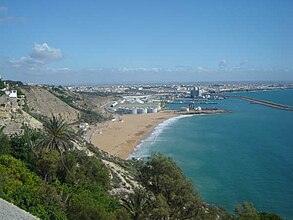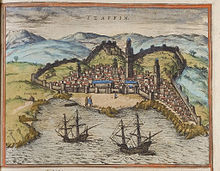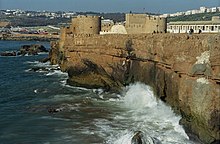Safi
| Safi أسفي ⴰⵙⴼⵉ |
||||
|---|---|---|---|---|
|
||||
| Basic data | ||||
| State : |
|
|||
| Region : | Marrakech-Safi | |||
| Province : | Safi | |||
| Coordinates | 32 ° 17 ′ N , 9 ° 14 ′ W | |||
| Residents : | 308,508 (2014) | |||
| Area : | 72.6 km² | |||
| Population density : | 4,249 inhabitants per km² | |||
| Height : | 20 m | |||
| Safi - View over the beach, port and city | ||||
Safi (from the mazirischen ⴰⵙⴼⵉ Asfi , "flood"; Arabic أسفي, DMG Asfī orآسفي / Asfi ) is a 350,000 inhabitants city in the region Marrakech-Safi in Morocco .
Location and climate
Safi is located directly on the Atlantic Ocean at a distance of about 250 km (driving distance) to Casablanca in the north, about 150 km to Essaouira and about 300 km to Agadir in the south. It is about 150 km to Marrakech to the east . The climate is largely influenced by the Atlantic; Rain (approx. 350 mm / year) falls almost exclusively in the winter months.
Population development
| year | 1994 | 2004 | 2014 |
| Residents | 262.276 | 284,750 | 308.508 |
The city's population consists almost exclusively of immigrant members of various Berber tribes from the area.
economy
Safi is - after Casablanca - the most important port and industrial location in the country. The hinterland of Safi - especially the region around Youssoufia and Khouribga - is very rich in phosphate; The rocky and dust-dry soils are blasted, dredged, crushed, chemically processed into granulate and exported as fertilizer. The entire phosphate production in Morocco as well as the further processing and export are in the hands of the state Office Chérifien des Phosphates (OCP) . In recent years there has been increasing talk of health and environmental problems caused by industrial dust and chemical processing. In addition, other branches of industry (chemistry, textiles) have settled in and around Safi in the last few decades.
Safi is also important as a fishing port; the catch (mainly sardines ) is largely processed in the canning factories on the port site. The preservation of fruit, vegetables, tomatoes, etc. also plays an important role in the city's economic life.
Safi is also known for its ceramic markets and ceramic industry. In addition to decorative and functional ceramics, the green glazed roof tiles that are used to cover mosques , mausoleums , medersas and royal palaces in Morocco are made here from longitudinally divided, slightly conical tubes that are turned on the potter's wheel .
history
The geographer Idrisi (12th century) and the scholar Ibn Chaldūn (14th century) reported that Asfi / Safi was an important port city. After the Genoese had already established a base in Safi in 1253, the further history of which, however, remains in the dark, the Portuguese founded a trading post for slaves, gold and ivory as a stopover on their way to black Africa and India in the middle of the 15th century. From 1508 to 1541 the city was firmly in Portuguese hands and was surrounded by an approx. 3 km long sloping wall. However, due to repeated attacks by the Berbers in the first half of the 16th century, the Portuguese had to give up the place again. As a trading city, Safi was still important; In the 17th and 18th centuries there were lively contacts to Europe. In 1751, King Frederick V of Denmark tried - ultimately unsuccessfully - to secure Danish bases in Safi and Santa Cruz do Cabo de Gué or Cabo de Aguer (today's Agadir ) by concluding a friendship and trade treaty with Mulai Muhammad , the governor of Marrakech erect.

Attractions
- The new town, which takes up over 90% of the total area of Safi, appears spacious and modern, but also stereotypical. The old town ( medina ) within the Portuguese city walls with its maze of alleys, on the other hand, appears lively and pristine; Here, living, handicrafts and retail trade combine to create an overall impression with a medieval feel.
- Outside the old town walls , to the west of the Place de l´Indépendance , the Portuguese fortress Dar el-Bahr ("Sea Castle ") was built in the 16th century with interesting bronze cannons that were added later. The southern tower of the fortress offers a beautiful view of the old town.
- The Great Mosque ( Jemaa el Kebir ) with its unplastered minaret from the Almohad times is well worth seeing ; it rises on the site of the - possibly unfinished - Portuguese cathedral from the 16th century.
- In the south of the mosque of the remained Manueline style built choir of Christian church architecture (Chapelle Portugaise) receive.
- On the eastern edge of the old town is the imposing fortress Borj ed-Dar ("Fortress of the Residence"), also from Portuguese times , which is also called Kechla (derived from the Portuguese castelejo ). Within the strong walls there is a small mosque and the palace (Dar el- Makhzen ) , which houses a ceramic museum.
Personalities
- Michel Galabru (1922–2016), actor and comedian
- Mohammed Benhima (1924–1992), Prime Minister of Morocco
- Michel Marie Jacques Dubost (* 1942), French clergyman, bishop emeritus of Evry-Corbeil-Essonnes
- Esther Galil (* 1945), chanson singer and songwriter
Others
- Saffian leather is named after the city of Safi ( called Tzaffin in Europe ) , a leather made from goat and sheep skin that has been very popular in Europe since the Baroque period.
- On May 25, 1969 and May 17, 1970, Safi was the starting point for Thor Heyerdahl's two attempts to cross the Atlantic with the papyrus boats Ra and Ra II , thus demonstrating the possibility of early cultural contact from North Africa (Egypt) to Central and South America.
Twin cities
-
 Boulogne-sur-Mer , France (since 1957)
Boulogne-sur-Mer , France (since 1957) -
 Région Nord-Pas-de-Calais , France
Région Nord-Pas-de-Calais , France -
 Setúbal , Portugal
Setúbal , Portugal -
 Sfax , Tunisia (since 1982)
Sfax , Tunisia (since 1982) -
 Montereau-Fault-Yonne , France (since 2007)
Montereau-Fault-Yonne , France (since 2007)
literature
- Arnold Betten: Morocco. Antiquity, Berber Traditions and Islam - History, Art and Culture in the Maghreb. DuMont, Ostfildern 2012, ISBN 978-3-7701-3935-4 , p. 320ff.
- Ingeborg Lehmann, Rita Henß : Morocco. Baedeker, Ostfildern 2010, ISBN 978-3-8297-1251-4 , p. 398ff.
Web links
- Safi - photos + brief information
- Safi, Chapelle Portugaise - Photos + Info (French)
- Morocco's phosphate industry




